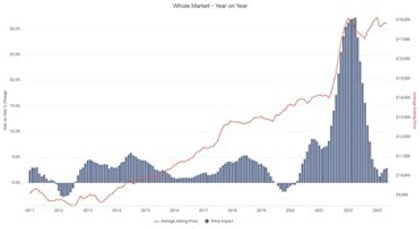Close
Back
Retail Price Index | May 2023

Used EV prices continue decline in wake of supply surge, but growing affordability fuels strong demand

According to the latest data from the Auto Trader Retail Price Index the average price of a used car increased 2.8% last month to £17,815, making May the 38th consecutive month of year-on-year (YoY) retail price growth. Although it’s the largest YoY increase in six months, potential retail growth remains constrained by used electric vehicle (EV) prices, which fell 18.6% in May, as the huge surge of stock entering the market (up 201%[1] YoY in May) continues to outpace very robust levels of consumer demand (up 44% YoY). Market dynamics of high demand and low supply in the used EV sector last year, which caused prices to rise, mean that current price drops largely represent a recalibration.
Despite marking the highest rate of YoY retail price contraction recorded by the Index, there are signs of used EV values beginning to stabilise, with the rate of decline only marginally greater than the -18.1% drop seen in April.
Strong retail price growth in the wider retail market is being stimulated by the opposite imbalance of supply and demand dynamics. Whilst consumer demand remains strong, as reflected in the 12% YoY (77.3 million) increase in cross platform visits to Auto Trader in May, levels of supply on the marketplace are down 6% YoY. This imbalance is not only keeping second-hand car prices stable, but also supporting a healthy and profitable used car market. Accordingly, Auto Trader’s Market Health[2] metric was up 12% YoY last month.
The speed at which cars are selling is another key indicator of market health. Last month, used cars took an average of 28 days to leave retailers’ forecourts, four days faster than in May 2022 (32).
The health of the used car market remains extremely buoyant, as despite growing pressures on household finances, we continue to see car buying demand on our marketplace well ahead of last year’s levels. With no imminent change to the current market dynamics, we can expect used car prices to stay strong for the foreseeable future, which should help retailers maintain robust margins.

Closing EV – ICE gap fuelling significant used EV demand.
Looking at the used EV pricing data at a more granular level reveals just how fragile the used electric vehicle market is. Although the current rate of used EV supply growth is slowing – at 201% YoY, May marked the lowest rate of growth since October 2022[3] – the market continues to see a huge influx of stock. There are currently circa 15,000 used EVs for sale each day on Auto Trader, 29% of which is now under £20,000, which is up significantly on the 7% recorded in August 2022. As the availability of more affordable electric cars has increased, so too has consumer demand, with the share of EV enquiries generated through Auto Trader for the one-to-five-year age range almost doubling over the last 12 months, from 4% to 7.3%, the highest level ever recorded.
The drop in average EV prices has significantly closed the upfront price gap between many electric models and their ICE counterparts, and in some cases, made them cheaper. For example, a three-year-old electric Jaguar I-PACE is now £600 cheaper than a traditionally fuelled F-PACE. And with retailers slashing the prices of used Teslas more than any other brand in response to new car price reductions, the average price of a used 3-year-old Model 3 (£30,700) is now just £3,600 more expensive than a BMW 3 Series of the same age - in August the price gap was a whopping £22,000. As a result, the Model 3’s market share of electric enquiries through Auto Trader has shot up from 8% to nearly one in five (18%) over the same period.
Walker continued: “Although prices are still falling, the rate of decline is beginning to show signs of stabilising as the levels of supply and demand start to improve. However, while the rate of supply entering the market is slowing, we’re going to continue to see very large volumes over the coming months. By the end of this year, we can expect around a million electric vehicles on the road, and demand will need to keep pace. The expanding range of affordable options should help encourage more people to make the switch.”
As supply and demand dynamics improve, used electric cars are starting to sell faster, with the average EV taking 42 days to sell in May, which is down from a peak of 47 days in January. However, the speed of sale lags far behind petrol and diesel cars, which both took an average of just 27 days to leave forecourts last month. The Tesla dynamics impacting price are also seeing used Teslas fly off the forecourt with an average of 22 days to sell, almost half of the overall used EV average.
Sue Robinson, Chief Executive of the National Franchised Dealers Association (NFDA), added: “Used vehicle prices continue to rise and are offering great opportunities for retailers’ return on investments. With 38 consecutive months of year-on-year growth for used vehicles, it would be great see this streak continue for a while longer. It’s also positive to see used EV retail prices begin to stabilise. NFDA’s Electric Vehicle Approved (EVA) scheme positions dealers at the forefront of EV retail and are critical information hubs for consumers seeking to make their transition to electric and debunking any misconceptions relating to used EVs.”
Top 10 used car price growth (all fuel types) | May 2023 vs May 2022 like-for-like
Top 10 used car price contraction (all fuel types) | May 2023 vs May 2022 like-for-like
About the Retail Price Index
The Auto Trader Retail Price Index (RPI) is published monthly and provides an overview of the latest price and search data from our marketplace. Our team of data scientists monitor circa 800,000 vehicles each day, including 116,000 vehicle updates and an average of 39,000 vehicles added or removed from Auto Trader. Coupled with data from circa 450,000 trade car listings every day, as well as additional retailer forecourts and website data (OEM, fleet and leasing disposal prices and pricing data from over 3,000 car dealership websites and data from major auction houses across the UK), ensuring the Index is an accurate reflection of the live retail market.
About Auto Trader
Auto Trader Group plc is the UK’s largest automotive marketplace. It listed on the London Stock Exchange in March 2015 and is a member of the FTSE 100 Index.
Auto Trader’s purpose is Driving Change Together. Responsibly. Auto Trader is committed to creating a diverse and inclusive culture, it aims to build stronger partnerships with its customers and use its voice and influence to drive more environmentally friendly vehicle choices.
With the largest number of car buyers and the largest choice of trusted stock, Auto Trader’s marketplace sits at the heart of the UK car buying process. That marketplace is built on an industry-leading technology and data platform, which is increasingly used across the automotive industry. Auto Trader is continuing to bring more of the car buying journey online, creating an improved buying experience, whilst enabling all its retailer partners to sell vehicles online.
Auto Trader publishes a monthly used car Retail Price Index which is based on pricing analysis of circa 800,000 unique vehicles. This data is used by the Bank of England to feed the broader UK economic indicators.
For more information, please visit: https://plc.autotrader.co.uk/
[1] Based on the volume of stock advertised on Auto Trader
[2] The Market Health metric shows the ratio of supply vs demand compared to the previous year.
[3] Supply of used EVs in October 2022 were up 187% year-on-year
Follow us on our social channels to keep up with the latest news, insights and company developments.
If you would like to be added to our News & views mailing list, or have any media-related enquiries, please contact our press team:

Looking to join the team?
Looking to make a sale?
Looking to make a purchase?
Sign up to our email alerts service:
Join our news & views mailing list
or submit media-related enquiries: